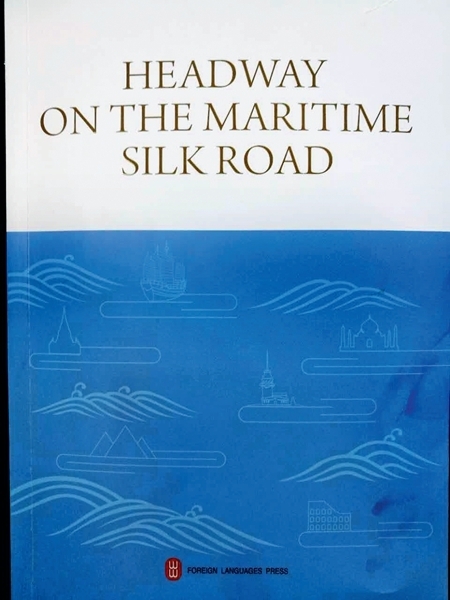Tracing Maritime Silk Road beyond time and space
- By staff reporter Zhou Lin
 0 Comment(s)
0 Comment(s) Print
Print E-mail China Today, July 28, 2017
E-mail China Today, July 28, 2017
The so-called Maritime Silk Road was a sea passage from ancient China to other regions of the world. This epic route acted as a medium for economic and cultural exchanges among countless itinerant merchants, thinkers and religious proselytizers, and was thus witness to the life and times of generations of travelers.
|
Headway on the Maritime Silk Road Executive editors: Zeng Huijie, Tao Hong Price: RMB 90 Paperback Published by Foreign Languages Press |
Headway on the Maritime Silk Road tells the life stories and family legends of 30 or more people from around 10 countries along the Maritime Silk Road. It comprises eight chapters, entitled, "Pathfinders"; "Passing on Traditional Handicrafts"; "Tea Ties Families to Their Ancestral Roots"; "Transnational Marriages"; "Technology Transfers"; "Exploring the Potential of TCM"; "Spreading China's Culture"; and "Trade Winds." These stories underline how China's proposal of the Belt and Road Initiative also constituted the interests of countries along the route. The book includes nearly 400 selected pictures that showcase the fascinating human landscapes and natural sceneries along this ancient passage.
The idea for the book originates in the eponymous TV documentary. Gu Yun, its director, remarked that the program's main distinction lay in its emphasis on the here and now. "There were no interviews and minimal narration. We just shot continuing stories from a historical perspective."
The first chapter "Pathfinders" tells of China's modern navigator Zhai Mo, who boldly sailed his yacht along the Maritime Silk Road to Milan for Expo 2015, and Malaysian author Datuk Wu Hengcan, who verified the authenticity of ancient documents recording eminent Tang Dynasty (618-907) monk Master Yijing's passage along the route. The third story is set in the early 1980s, when a group of young French navigators commissioned Guangzhou shipyard to build the Lady Guangzhou – a replica of an ancient Chinese ship, with the idea of cruising the old maritime trade route to Paris. The three stories are interwoven, spanning ancient to modern times. They offer insights into the history of China's navigation, ship-building, and maritime foreign exchanges.
"Time flows but it cannot remove genes. Modern generations have inherited their ancestors' undertakings, some of which still intersect today," Gu Yun said. "The story of Lady Guangzhou started in 1982. Thirty years later, Vincent, his fellow French navigators and their Chinese partner Huang Zongfu reunited in Guangzhou. We found film data from 30 years ago that adds a sense of historical volatility to the story."
The book has been commended for its multi-dimensional interpretation of history. The Maritime Silk Road was both a passage for civil exchanges and a path on which adventurers discovered new outposts. Certain clans helped civilization prosper on the Silk Road over millennia. Stories include accounts of the Lan family, famous for Suzhou embroidery; the Liang family of Guangzhou and their "Wuchanghao" porcelain; Tang Chunfu, master of the dry lacquering craft; and the Maruya Hatcho Miso company and its current trustee Asai, who insists on sticking to the traditional sauce making process.
The Maritime Silk Road was also known as the Tea Trail. The book hence records the development of Wang Wenli and Wei Rongnan's Family Anxi Tieguanyin Tea Business, and their century-old Tea Houses in Thailand and Singapore. They set off from Nanyang, the ancestral hometown, and traveled the route to bring tea to the European and American continents. Their family stories show how Chinese tea spread to every corner of the world and became part of the Western lifestyle. They also put across the impact of the tea trade on global commerce.
Over the long course of history, intermarriage has facilitated the cultural fusion and interaction of various ethnic groups. The stories of tea trader Anura Banda from Sri Lanka and businessman Chikwendu from the Association of Nigerian Community in China and their Chinese wives, as well as of the Baba-Nyonya culture – fruit of the fusion of the Chinese and Malaysian cultures, all display the inclusiveness of Chinese civilization.
Flourishing trade along the Maritime Silk Road gave rise to scientific and technological exchanges and technical cooperation. The book selects several stories of businessmen, among them Lin Mengde – an entrepreneur from Shanwei, eastern Guangdong Province, who engaged in aquaculture with companies in Brunei; Tommy Winata, environmentalist and president of AG Group who launched a pilot hybrid rice-planting demonstration project in Indonesia; and Banthoon Lamsam, president of Kasikornbank, who led his team to weather the financial crisis, and offered Linglong Tire its first bank loan when it started doing business in Thailand.
Traditional Chinese medicine, Chinese cuisine, martial arts, language and literature, and opera have all traveled the route to the world at large. Also among these stories, therefore, are that of famous TCM doctor Fan Zhenglun and his followers in countries along the maritime silk route; the efforts of Zhuang Chen – promoter of Cantonese cuisine; Cantonese opera singer Ge Ruijuan's contribution to the promotion of the local opera through cultural exchanges; foreign disciples' acknowledgement of their master at Shaolin Temple in Quanzhou; and Indonesian Chinese entrepreneur Guo Zaiyuan's spreading of Chinese culture to the world. Formless and intangible, these stories seem unrelated to major state affairs, but their spirit has been integral to spreading cultural influences, and they also serve as an important embodiment of Chinese nation's soft power. Along with the passion for learning Chinese, the country's profound civilization has spread throughout the world.
The Maritime Silk Road integrates the present with the past, China with the rest of the world, and the flow of civilization with the transmigration of space and time. The stories of these key characters and their descendants are like a scroll painting that depicts China's active participation in building the 21st-Century Maritime Silk Road.







Go to Forum >>0 Comment(s)